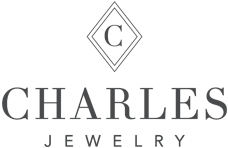We get it- buying an engagement ring is one of life’s biggest moments. As if purchasing the right stone isn’t stressful enough, choosing the right metal for your engagement ring is equally important. Luckily, we are here to give our thoughts on what to consider when it comes to determining the right precious metal for your engagement ring.
With over a decade of experience in high-end jewelry, read below for the Charles Jewelry take on platinum vs gold:
Appearance and Maintenance
The striking sheen of platinum makes it the precious metal of choice for the highest quality jewelry. Unlike white gold which on occasion will be treated with Rhodium to maintain its appearance, the magnificent appearance of platinum stands on its own. The heavy weight, resistance to corrosion and durability of platinum make it a metal that will not wear away with constant use. Platinum is the strongest of jewelry metals. It can, however, scratch and develop a patina of wear. Many people find this look unique to platinum as well as very attractive. Soaking platinum in a solution of soap and warm water while gently scrubbing it with a soft-bristled brush at home is all that is required to maintain the metal’s luster. Buffing with a soft cloth will usually bring mildly scratched platinum jewelry to its pristine luster. For more severe scratches, a jeweler can easily polish your jewelry to bring back the original finish.
Gold has been the most sought after of precious metals through all the ages of man. Its value dates back to prehistoric times. It has served as money, a store of value, and as jewelry. Gold occurs as nuggets or grains in rocks. Gold will not tarnish, rust, or corrode. Gold should be kept away from harsh chemicals. Warm water and detergent-free soap may be used with a soft-bristled brush (a dull tooth brush works well) to clean gold jewelry.
If a person is allergic to nickel or other alloy metals then 18 karat, 22 karat or even pure gold may be their metal of choice. Gold filled or plated jewelry will serve for occasionally worn jewelry. Every day use of gold plated jewelry will wear down the gold layer. This may result in discoloration of your skin or an allergic reaction. For pieces that will last a lifetime, we suggest using the highest quality your budget allows.
Pricing
Platinum is far more precious than gold. The price of platinum varies with market conditions but normally is almost twice the price of 14K gold.
The value of gold jewelry is dependent upon the karat weight, as well as the design, construction and beauty of the piece.
With this being said, we suggest that no more than ten percent of your overall budget for an engagement ring (or any jewelry design) should go towards the metal components. For example, if your overall budget is $6,000 and you want to go with platinum, that will use up a significant portion of the budget versus going with white gold. The additional money saved can go towards making a bigger visual impact with diamonds, etc. which often times our clients prefer.
Composition
Platinum jewelry is classified by the amount of platinum it contains. Platinum content is measured in parts per thousand of metal composition. The number you will see shows how many parts per one thousand is pure platinum. If you see ’850 Plat’ marking, it has 850 parts platinum out of 1000 total parts.
Pure gold is considered too soft for jewelry use in Western society. Western cultures are concerned that pure gold jewelry will easily be scratched or deformed. In Western culture, gold is mixed with metals such as silver, copper, nickel, or zinc to give it strength and durability. Yellow Gold found in jewelry is most often 14k or 18k. Because 14k jewelry has less gold in its composition, its color is not as rich as 18k. 14k gold is often the composition of choice when strength and durability are desirable. Examples might be earring backs, bracelet clasps, or a gold necklace or religious chain that is to be worn every day.
Jewelry grade gold is created by mixing it with rhodium, nickel, or Palladium. To many, rhodium is the alloy of choice because of its tough hard shine. Nickel can be mixed with gold to create a white (gray) color, but it may cause dermatitis in people sensitive to it. Palladium may also be used to create white gold but is less commonly used to do so.
The “Karatage” of gold is shown with a number followed by “k”. This refers to its purity, or the amount of true gold included in the metal. 100% gold is traditionally referred to as 24 karat.
The addition of copper creates “Rose gold”. The addition of copper gives gold a beautiful pink color; the more copper, the deeper the effect.
The color of gold is determined by:
• The metal alloys with which it is mixed.
• The percentage of each metal alloy in the total composition of the piece.
What this all boils down to is that there is no right or wrong decision to be made when it comes to determining what metal to use. The most important factor when choosing what metal (or any other component) is being informed. Finding a jeweler that you trust and is willing to spend the time educating you on what options are available will ensure an end product that you will love forever.
